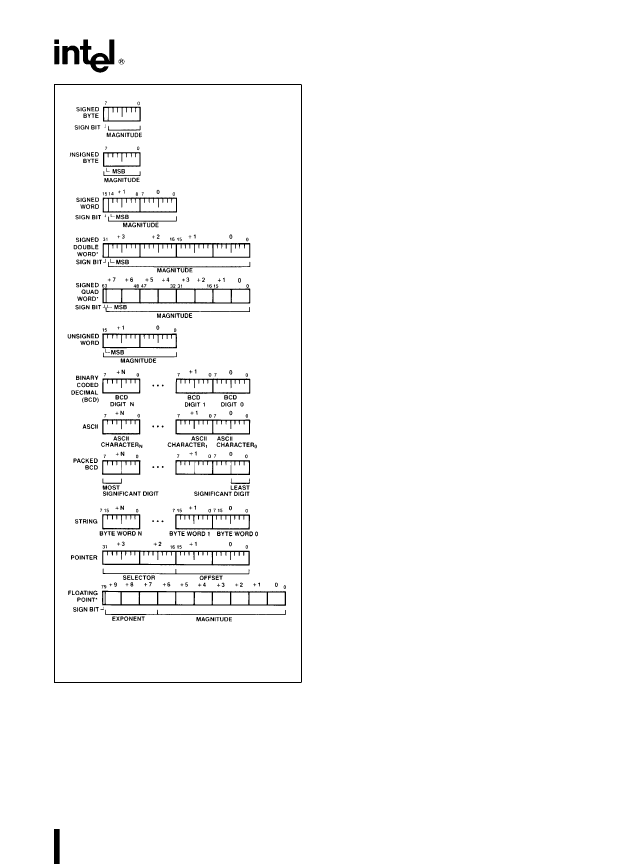- 您現(xiàn)在的位置:買賣IC網(wǎng) > PDF目錄377495 > intel M80C186 (Intel Corp.) CHMOS High Integration 16-Bit Microprocessor(CHMOS 高集成16位微處理器) PDF資料下載
參數(shù)資料
| 型號: | intel M80C186 |
| 廠商: | Intel Corp. |
| 英文描述: | CHMOS High Integration 16-Bit Microprocessor(CHMOS 高集成16位微處理器) |
| 中文描述: | CHMOS高集成的16位微處理器(CHMOS高集成16位微處理器) |
| 文件頁數(shù): | 15/59頁 |
| 文件大?。?/td> | 529K |
| 代理商: | INTEL M80C186 |
第1頁第2頁第3頁第4頁第5頁第6頁第7頁第8頁第9頁第10頁第11頁第12頁第13頁第14頁當前第15頁第16頁第17頁第18頁第19頁第20頁第21頁第22頁第23頁第24頁第25頁第26頁第27頁第28頁第29頁第30頁第31頁第32頁第33頁第34頁第35頁第36頁第37頁第38頁第39頁第40頁第41頁第42頁第43頁第44頁第45頁第46頁第47頁第48頁第49頁第50頁第51頁第52頁第53頁第54頁第55頁第56頁第57頁第58頁第59頁

M80C186
270500–7
NOTE:
*
Supported by using a Numeric Data Coprocessor with
the M80C186.
Figure 7. M80C186 Supported Data Types
Programs may cause an interrupt with an INT in-
struction. Instruction exceptions occur when an un-
usual condition, which prevents further instruction
processing, is detected while attempting to execute
an instruction. If the exception was caused by exe-
cuting an ESC instruction with the ESC trap bit set in
the relocation register, the return instruction will
point to the ESC instruction, or to the segment over-
ride prefix immediately preceding the ESC instruc-
tion if the prefix was present. In all other cases, the
return address from an exception will point at the
instruction immediately following the instruction
causing the exception.
A table containing up to 256 pointers defines the
proper interrupt service routine for each interrupt. In-
terrupts 0–31, some of which are used for instruc-
tion exceptions, are reserved. Table 4 shows the
M80C186 predefined types and default priority lev-
els. For each interrupt, an 8-bit vector must be sup-
plied to the M80C186 which identifies the appropri-
ate table entry. Exceptions supply the interrupt
vector internally. In addition, internal peripherals and
noncascaded external interrupts will generate their
own vectors through the internal interrupt controller.
INT instructions contain or imply the vector and al-
low access to all 256 interrupts. Maskable hardware
initiated interrupts supply the 8-bit vector to the CPU
during an interrupt acknowledge bus sequence.
Non-maskable hardware interrupts use a predefined
internally supplied vector.
Interrupt Sources
The M80C186 can service interrupts generated by
software or hardware. The software interrupts are
generated by specific instructions (INT, ESC, unused
OP, etc.) or the results of conditions specified by
instructions (array bounds check, INT0, DIV, IDIV,
etc.). All interrupt sources are serviced by an indirect
call through an element of a vector table. This vector
table is indexed by using the interrupt vector type
(Table 4), multiplied by four. All hardware-generated
interrupts are sampled at the end of each instruc-
tion. Thus, the software interrupts will begin service
first. Once the service routine is entered and inter-
rupts are enabled, any hardware source of sufficient
priority can interrupt the service routine in progress.
The software generated M80C186 interrupts are de-
scribed below.
DIVIDE ERROR EXCEPTION (TYPE 0)
Generated when a DIV or IDIV instruction quotient
cannot be expressed in the number of bits in the
destination.
SINGLE-STEP INTERRUPT (TYPE 1)
Generated after most instructions if the TF flag is
set. Interrupts will not be generated after prefix in-
structions (e.g., REP), instructions which modify seg-
ment registers (e.g., POP DS), or the WAIT instruc-
tion.
NON-MASKABLE INTERRUPTDNMI (TYPE 2)
An external interrupt source which cannot be
masked.
15
相關PDF資料 |
PDF描述 |
|---|---|
| intel Pentium CPU | 32 Bit CPU With MMX Technology and Mobile Module(32位帶MMX和移動模塊處理器) |
| intel Pentium II processor | Pentium II Processor Mobile Module(帶移動模塊奔II處理器) |
| INTEL386 CXSA | 5-V 32-Bit Fully Static Embedded Microprocessor(5V,32位完全靜態(tài)嵌入式微處理器) |
| INTEL386 CXSB | Low-Voltage, 32-Bit, Fully Static Embedded Microprocessor(低電壓32位完全靜態(tài)嵌入式微處理器) |
| intel386 DX | 32-Bit CHMOS Microprocessor With Integrated Memory Management(32位CHMOS 微處理器帶集成存儲管理) |
相關代理商/技術參數(shù) |
參數(shù)描述 |
|---|---|
| INTEN I/O PCB | 制造商:Sliger Designs, Inc. 功能描述:I/O PCB - Bulk |
| INTEN LED PCB | 制造商:Sliger Designs, Inc. 功能描述:LED PCB - Bulk |
| INTEN-1-PROTO | 制造商:Sliger Designs, Inc. 功能描述:QUANTITY TWO PROTO TYPE SHEET METAL - Bulk |
| INTENSI-FI | 制造商:BOARDCOM 制造商全稱:Broadcom Corporation. 功能描述:DRAFT-802.11n PRODUCT FAMILY |
| INTER0.5 | 制造商:POWERDATA TECHNOLOGIES 功能描述:LEAD WIELAND TO WIELAND 0.5M |
發(fā)布緊急采購,3分鐘左右您將得到回復。